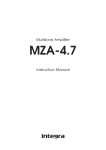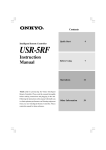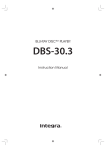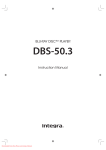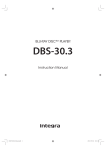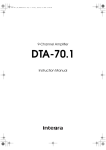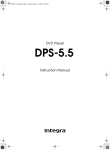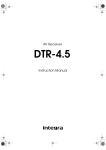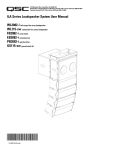Download Integra DTA-9.4 User's Manual
Transcript
Contents Seven Channel Amplifier DTA-9.4 Before using Instruction Manual Operations Connections Thank you for purchasing the Integra Seven Channel Amplifier. Please read this manual thoroughly before making connections and plugging in the unit. Following the instructions in this manual will enable you to obtain optimum performance and listening enjoyment from your new Seven Channel Amplifier. Please retain this manual for future reference. Appendix En WARNING: TO REDUCE THE RISK OF FIRE OR ELECTRIC SHOCK, DO NOT EXPOSE THIS APPLIANCE TO RAIN OR MOISTURE. CAUTION: TO REDUCE THE RISK OF ELECTRIC SHOCK, DO NOT REMOVE COVER (OR BACK). NO USER-SERVICEABLE PARTS INSIDE. REFER SERVICING TO QUALIFIED SERVICE PERSONNEL. WARNING AVIS RISK OF ELECTRIC SHOCK DO NOT OPEN RISQUE DE CHOC ELECTRIQUE NE PAS OUVRIR The lightning flash with arrowhead symbol, within an equilateral triangle, is intended to alert the user to the presence of uninsulated “dangerous voltage” within the product’s enclosure that may be of sufficient magnitude to constitute a risk of electric shock to persons. The exclamation point within an equilateral triangle is intended to alert the user to the presence of important operating and maintenance (servicing) instructions in the literature accompanying the appliance. Important Safeguards 1. Read Instructions – All the safety and operating instructions should be read before the appliance is operated. 2. Retain Instructions – The safety and operating instructions should be retained for future reference. 3. Heed Warnings – All warnings on the appliance and in the operating instructions should be adhered to. 4. Follow Instructions – All operating and use instructions should be followed. 5. Cleaning – Unplug the appliance from the wall outlet before cleaning. The appliance should be cleaned only as recommended by the manufacturer. 6. Attachments – Do not use attachments not recommended by the appliance manufacturer as they may cause hazards. 7. Water and Moisture – Do not use the appliance near water –for example, near a bath tub, wash bowl, kitchen sink, or laundry tub; in a wet basement; or near a swimming pool; and the like. 8. Accessories – Do not place the appliance on an unstable cart, stand, tripod, bracket, or table. The appliance may fall, causing serious injury to a child or adult, and serious damage to the appliance. Use only with a cart, stand, tripod, bracket, or table recommended by the manufacturer, or sold with the appliance. Any mounting of the appliance should follow the manufacturer’s instructions, and should use a mounting accessory PORTABLE CART WARNING recommended by the manufacturer. 9. An appliance and cart combination should be moved with care. Quick stops, excessive force, and uneven surfaces may cause the S3125A appliance and cart combination to overturn. 10. Ventilation – Slots and openings in the cabinet are provided for ventilation and to ensure reliable operation of the appliance and to protect it from overheating, and these openings must not be blocked or covered. The openings should never be blocked by placing the appliance on a bed, sofa, rug, or other similar surface. The appliance should not be placed in a built-in installation such as a bookcase or rack unless proper ventilation is provided. There should be free space of at least 20 cm (8 in.) and an opening behind the appliance. 11. Power Sources – The appliance should be operated only from the type of power source indicated on the marking label. If you are not sure of the type of power supply to your home, consult your appliance dealer or local power company. 12. Grounding or Polarization – The appliance may be equipped with a polarized alternating current line plug (a plug having one blade wider than the other). This plug will fit into the power outlet only one way. This is a safety feature. If you are unable to insert the plug fully into the outlet, try reversing the plug. If the plug should still fail to fit, contact your electrician to replace your obsolete outlet. Do not defeat the safety purpose of the polarized plug. 2 13. Power-Cord Protection – Power-supply cords should be routed so that they are not likely to be walked on or pinched by items placed upon or against them, paying particular attention to cords at plugs, convenience receptacles, and the point where they exit from the appliance. 14. Lightning – For added protection for the appliance during a lightning storm, or when it is left unattended and unused for long periods of time, unplug it from the wall outlet and disconnect the antenna or cable system. This will prevent damage to the appliance due to lightning and power-line surges. 15. Overloading – Do not overload wall outlets, extension cords, or integral convenience receptacles as this can result in a risk of fire or electric shock. 16. Object and Liquid Entry – Never push objects of any kind into the appliance through openings as they may touch dangerous voltage points or short-out parts that could result in a fire or electric shock. Never spill liquid of any kind on the appliance. 17. Servicing – Do not attempt to service the appliance yourself as opening or removing covers may expose you to dangerous voltage or other hazards. Refer all servicing to qualified service personnel. 18. Damage Requiring Service – Unplug the appliance form the wall outlet and refer servicing to qualified service personnel under the following conditions: A. When the power-supply cord or plug is damaged, B. If liquid has been spilled, or objects have fallen into the appliance, C. If the appliance has been exposed to rain or water, D. If the appliance does not operate normally by following the operating instructions. Adjust only those controls that are covered by the operating instructions as an improper adjustment of other controls may result in damage and will often require extensive work by a qualified technician to restore the appliance to its normal operation, E. If the appliance has been dropped or damaged in any way, and F. When the appliance exhibits a distinct change in performance – this indicates a need for service. 19. Replacement Parts – When replacement parts are required, be sure the service technician has used replacement parts specified by the manufacturer or have the same characteristics as the original part. Unauthorized substitutions may result in fire, electric shock, or other hazards. 20. Safety Check – Upon completion of any service or repairs to the appliance, ask the service technician to perform safety checks to determine that the appliance is in proper operation condition. 21. Wall or Ceiling Mounting – The appliance should be mounted to a wall or ceiling only as recommended by the manufacturer. 22. Heat – The appliance should be situated away from heat sources such as radiators, heat registers, stoves, or other appliances (including amplifiers) that produce heat. 23. Liquid Hazards – The appliance shall not be exposed to dripping or splashing and no objects filled with liquids, such as vases shall be placed on the appliance. Precautions 1. Recording Copyright Recording of copyrighted material for other than personal use is illegal without permission of the copyright holder. 2. AC Fuse The fuse is located inside the chassis and is not user-serviceable. If power does not come on, contact your Integra/Onkyo authorized service station. 3. Care From time to time you should wipe the front and rear panels and the cabinet with a soft cloth. For heavier dirt, dampen a soft cloth in a weak solution of mild detergent and water, wring it out dry, and wipe off the dirt. Following this, dry immediately with a clean cloth. Do not use rough material, thinners, alcohol or other chemical solvents or cloths since these could damage the finish or remove the panel lettering. 4. Power For Canadian models For models having a power cord with a polarized plug: CAUTION: TO PREVENT ELECTRIC SHOCK, MATCH WIDE BLADE OF PLUG TO WIDE SLOT, FULLY INSERT. Modèle pour les Canadien Sur les modèles dont la fiche est polarisée: ATTENTION: POUR ÉVITER LES CHOCS ÉLECTRIQUES, INTRODUIRE LA LAME LA PLUS LARGE DE LA FICHE DANS LA BORNE CORRESPONDANTE DE LA PRISE ET POUSSER JUSQU’AU FOND. WARNING BEFORE PLUGGING IN THE UNIT FOR THE FIRST TIME, READ THE FOLLOWING SECTION CAREFULLY. The voltage of the available power supply differs according to country or region. Be sure that the power supply voltage of the area where this unit will be used meets the required voltage (e.g., AC 230 V, 50 Hz or AC 120 V, 60 Hz) written on the rear panel. FCC INFORMATION FOR USER CAUTION: The user changes or modifications not expressly approved by the party responsible for compliance could void the user’s authority to operate the equipment. NOTE: This equipment has been tested and found to comply with the limits for a Class B digital device, pursuant to Part 15 of the FCC Rules. These limits are designed to provide reasonable protection against harmful interference in a residential installation. This equipment generates, uses and can radiate radio frequency energy and, if not installed and used in accordance with the instructions, may cause harmful interference to radio communications. However, there is no guarantee that interference will not occur in a particular installation. If this equipment does cause harmful interference to radio or television reception, which can be determined by turning the equipment off and on, the user is encouraged to try to correct the interference by one or more of the following measures: • Reorient or relocate the receiving antenna. • Increase the separation between the equipment and receiver. • Connect the equipment into an outlet on a circuit different from that to which the receiver is connected. • Consult the dealer or an experienced radio/TV technician for help. 3 Features ■ High output switching power supply dedicated to audio processing ■ Ultra low impedance design with extensive use of copper bus bar, large coil, and ultra heavy gauge wire ■ 7-channel integral PWM amplifier with completely discrete structure ■ Balanced XLR Inputs for Better Dynamic Range and Stability on long Cable Runs ■ Gold plated high quality grinded speaker terminals and RCA/XLR input terminals ■ High quality custom speaker terminals compatible with banana plugs ■ 12V trigger input terminal ■ Detachable power cord ■ 120 Watts per channel min. RMS. Into 8 ohms 2 channel driven, from 20 to 20,000 Hz with no more than 2.5 % total harmonic distortion Contents Before using Important Safeguards ......................................... 2 Precautions ......................................................... 3 Features ............................................................... 4 Contents .............................................................. 4 Supplied accessories ......................................... 5 Precautions ......................................................... 6 Operations Quick operation guide ........................................ 7 Front panel facilities ........................................... 8 Connections Rear panel facilities and connections .............. 9 Connecting speakers ....................................... 11 Connecting to the Integra AV Controller DTC-9.4 ......................................................... 12 Appendix Troubleshooting guide ..................................... 13 Specifications ................................................... 14 4 Supplied accessories Check that the following accessories are supplied with the DTA-9.4. Power cord × 1 Stereo mini-plug cable × 1 (for connecting to the 12V TRIGGER IN terminal on the CONTROL LINK-compatible Integra/Onkyo products) 5 Precautions Before using the DTA-9.4 power amplifier, be sure to read the page above entitled Important Safeguards and this page of precautions. Ventilation While using the DTA-9.4, the internal temperature will fairly rise. Excessive temperature rise may affect the amplifier performance. To prevent damage from occurring due to high internal temperatures, it is vital to have proper ventilation and passage of air to carry out the heat and keep the internal temperature within acceptable ranges. Caution • Do not place the DTA-9.4 inside cabinets or closets where there is poor passage of air and ventilation. • Do not place the DTA-9.4 near external heat sources such as heaters or hot air ducts. • Do not place other components or object on top of or under the DTA-9.4. • The cover of the DTA-9.4 contains ventilation holes to allow the passage of air. Do not cover or block these holes in any way. If you are planning to place it within a cabinet, either open holes in the rear panel of the cabinet to improve ventilation or use a fan to force air circulation. As a general rule, if during idling the cover is too hot to touch, then ventilation needs to be improved. Installation location and space Make sure that the floor or cabinet or rack where it will be located is strong enough to support its weight. You will also need to leave enough space behind the DTA-9.4 to allow room for the power cord and other cables for connecting system components. A minimum of four inches is required behind the DTA-9.4 to allow room for the cables and cords without excessively bending them. Do not place the DTA-9.4 near TV or radio. This may cause noise or instable video on radio or TV respectively. Care From time to time you should wipe the front and rear panels and the cabinet with a soft cloth. For heavier dirt, dampen a soft cloth in a weak solution of mild detergent and water, wring it out dry, and wipe off the dirt. Following this, dry immediately with a clean cloth. Do not use rough material, thinners, alcohol or other Chemical solvents or cloths since these could damage the finish or remove the panel lettering. Whenever performing maintenance on the DTA-9.4, any of its supplied accessories, or any device connected to it, do not use solvents or cleaners of any kind that are inflammable or combustible. When you clean the input/output terminals on the rear panel, do not use contact restorer. Doing so may cause resin deterioration. Other Below is a list of actions that you should never perform. • Do not use the DTA-9.4 as a broadcast system or musical instrument amplifier. • Never use a generator, DC/AC converter, AC/AC converter, or transformer to supply power for the DTA-9.4. • Never perform a “thumb test” (checking whether current is reaching the lead wire on the hot end of the input by touching it with your fingers) on the ends of the input jacks or input cables. Doing so may damage the speakers. • Do not short across the output terminals or across the output terminals and rear panel. • Never remove the cover of the DTA-9.4. • Do not install the DTA-9.4 in a location within the reach of small children. Lightning storms During lightning storm, never touch the power cord, plug or cover of the DTA-9.4, and any devices connected to the DTA-9.4. Power Power cord Do not use a power cord other than the one supplied with the DTA9.4. The power cord supplied is designed for use with the DTA-9.4 and should not be used with any other device. Be sure to only use wall sockets that properly fit the plug of the power cord. If the socket does not match the plug of the power cord, you will need to prepare an adapter. Always use an adapter that is properly certified for this application. Speakers Connected speakers should have an impedance of 4 ohms or greater. If speakers with an impedance of less than 4 ohms are connected, it may damage the DTA-9.4. 6 WARNING: BEFORE PLUGGING IN THE UNIT FOR THE FIRST TIME, READ THE FOLLOWING SECTION CAREFULLY. The voltage of the available power supply differs according to country or region. Be sure that the power supply voltage of the area where this unit will be used meets the required voltage (e.g., AC 120V, 60Hz). Quick operation guide Here is a quick guide for those who want to listen to music or view their favorite movies as soon as possible. Connections and operations are explained briefly here for the purpose of just getting you started. For those of you who want to operate the DTA-9.4 right away, follow the guide below. However, this instruction manual contains a great deal of other information that you should know for the proper operation of the DTA-9.4 and for a more pleasurable experience with the DTA-9.4. Be sure to read the rest of this manual as well after reading this quick guide. The procedures given below assume that the other system components are already connected. (For example, that the source components are already connected to the control amplifier.) 1. Lower the volume at the control amplifier. Lower the volume of the control amplifier to the minimum so that when the DTA-9.4 is turned on, you do not hear loud unwanted sounds. 2. Connect the speakers to the DTA-9.4. Connect the speakers to the DTA-9.4 using the proper speaker cables. Be sure to match the channels and the positive (+) and negative (–) polarities between the speakers and the DTA-9.4. If the connections are mistaken, the correct orientation will not be obtained. 3. Select balanced input (XLR) or unbalanced input (RCA) with the INPUT SELECT switch. The DTA-9.4 possesses a balanced input (XLR) and unbalanced input (RCA) for each channel and the switch for the two is located between the two input terminals. Select the proper input type depending on the functionality of the connected cables and control amplifier. Note: Do not change the INPUT SELECT switch setting when the DTA9.4 is turned on. 4. Connect the control amplifier to the DTA-9.4. After selecting the correct input type in step 3 above, connect the output from the control amplifier to the corresponding input terminal on the DTA-9.4. Note: Do not connect anything to the other input jack. 5. Connect the supplied power cord to the DTA-9.4 and to the wall power outlet. Be sure to properly plug the power cord all the way in. 6. Press the Power switch. When pressing this switch, the Standby indicator flashes red, and then the On indicator lights blue. When you connect other device to the 12V TRIGGER IN terminal using the supplied cable, the power on or off status of the DTA-9.4 synchronizes to the action of turning on or off the connected device. While the Standby indicator lights red, the DTA-9.4 is in standby state waiting for 12V trigger signal. 7. Slowly increase the control amplifier volume. Note: After the DTA-9.4 is turned on, it takes approximately 10 seconds before the output sounds. During this time, do not turn up the volume. Now all that remains is to control the control amplifier and the other connected system components and enjoy your music or movies. 7 Front panel facilities Power On / Off Turns on and off the main power supply for the DTA-9.4. Power Off: The DTA-9.4 turns off. Power On: When no device is connected to the 12V TRIGGER IN terminal, the DTA-9.4 turns on. When a device is connected to the 12V TRIGGER IN terminal, the DTA-9.4 turns on with the 12V trigger signal coming in or goes into standby state with no 12V trigger signal. (See page 10 for information on the 12V TRIGGER IN terminal.) Note: If you wish to turn on the DTA-9.4 again after it is turned off, wait for 30 seconds or more. 8 Standby indicator and On indicator When the Power switch is pressed, either indicator will light like following. The On indicator lighting Blue: The main power of the DTA9.4 is turned on and you can play and enjoy an input source. The Standby indicator lighting Red: The DTA-9.4 is in standby state and waits for instruction signal from the 12V TRIGGER IN terminal. Note: If the Power switch is pressed and both of the On and Standby indicators do not light, check that the Power cord is properly connected. If the indictors still do not light, turn off the DTA-9.4, disconnect the Power cord from wall outlet, and contact an Integra/ Onkyo service station or representative. If the On indicator lights blue and the Standby indicator flashes red, the protection circuitry of the DTA-9.4 has activated. The protection circuitry activates if a problem such as a speaker cable shorting or the temperature of the DTA-9.4 rising excessively occurs. Turn off the DTA-9.4, remove the cause of the problem, and then turn the DTA-9.4 back on. If the problem is still not solved, turn off the DTA-9.4, disconnect the power cord from wall outlet, and contact an Integra/Onkyo service station or representative. Rear panel facilities and connections Caution • Do not connect the Power cord until you have finished all other connections. • Read the instructions that came with the other components you are connecting. • Do not make connections to input or output jacks while the DTA-9.4 is turned on (Power • Turn the volume of the control amplifier down before turning on the DTA-9.4. SURROUND BACK RIGHT SURROUND RIGHT RIGHT LEFT CENTER SURROUND LEFT on). SURROUND BACK LEFT SEVEN CHANNEL AMPLIFIER MODEL NO. DTA-9.4 INPUT SELECT INPUT SELECT INPUT SELECT INPUT SELECT INPUT SELECT INPUT SELECT INPUT SELECT 12 V TRIGGER IN OUTPUT OUTPUT OUTPUT OUTPUT OUTPUT OUTPUT OUTPUT CONTROL LINK IN AC INLET Precaution for connection This unit comprises 7 independent power amplifiers, each being capable of reproducing the same quality sound through its channel. Note that you should connect an input source and a speaker to each channel in use. Leave any unused channels unconnected, if the DTA9.4 is used for 2- or 5-channel connection. Balanced Input (XLR terminal) Connect controllers or control amplifiers with balanced outputs for high-quality sound. 2 Push Note: • When using this balanced connection for a specific channel between the control amplifier and DTA-9.4, set the INPUT SELECT switch to the side (the balanced input side) to select balanced input. Next, use commercial XLR balanced cable and connect the balanced output from the control amplifier to the corresponding balanced input on the DTA-9.4. • Do not connect anything to the RCA-type audio input jack. 3 1 1. GND 2. Disconnecting the input terminal Pull out the connection cable while holding down the lever. 3. inverting (–) 2. non-inverting (+) Connector ground terminal: Chassis grounded The pin assignments for this terminal are given above. This pin assignment conforms to the standard adopted by the Audio Engineering Society. Refer to the instruction manual supplied with the control amplifier and verify that its output terminal is compatible with the pin assignments for this terminal. The output terminal of Integra DTC-9.4 is compatible with the pin assignments for the terminal of DTA-9.4. Input terminal 1. Connecting the input terminal Match the pins and insert the terminal until you hear a “click.” Make sure that the terminal is locked by lightly pulling the connection cable. INPUT SELECT / This switch is located between the balanced input and single-ended RCA input for each channel. Use this switch to select the input type for its channel. When pushing the switch to the side, the balanced input is selected. When pushing the switch to the side, the RCA audio input is selected. Note: • Do not change the INPUT SELECT switch setting when the DTA-9.4 is turned on. • Make sure that connections have been made only to the inputs selected with the INPUT SELECT switches and nothing is connected to the other ones. Unbalanced Input (single end RCA input) Connect controllers or control amplifiers with single-ended outputs. RCA type Note: • When using this single-ended connection for a specific channel between the control amplifier and DTA-9.4, set the INPUT SELECT switch to the side (the RCA audio input side) to select single-ended input. Next, use commercial RCA audio pin cable and connect the single-ended output from the control amplifier to the corresponding single-ended input on the DTA-9.4. • Do not connect anything to the balanced input jack. 9 Rear panel facilities and connections + OUTPUT – (Speaker output and binding post) The DTA-9.4 is equipped with high-current binding posts for use at output terminals to the speaker system. To obtain the best in sound quality from the DTA-9.4, we recommend the use of high-quality speaker cables. For each channel, connect the negative (white) output post to the negative input terminal of the speaker and the positive (red) output post to the positive input terminal of the speaker. AC INLET Plug the supplied Power cord into this AC INLET and then into the Power outlet on the wall. To an AC wall outlet 12V TRIGGER IN (CONTROL LINK IN) Connects to the 12V trigger output terminal on the other device to control the DTA-9.4. Connecting to the Integra DTC-9.4 AV controller: Use the attached stereo mini-plug cable to connect to the 12V TRIGGER OUT terminal on the DTC-9.4. Connecting to the 12V TRIGGER OUT B (CONTROL LINK OUT) terminal: This enables the DTA-9.4 to turn on or go into standby state based on the power on/standby status of the DTC-9.4. The brightness of the On or Standby indicator on the DTA-9.4 also switches automatically in 4 levels according to the dimmer setting (brightness adjustment of the display) of the DTC-9.4. Connecting to the 12V TRIGGER OUT A terminal: This enables the DTA-9.4 to turn on or go into standby state based on the power on/standby status of the DTC-9.4. Note: Be sure to use the attached stereo mini-plug cable for connecting to the DTC-9.4. Using any other cables does not allow control of the DTA-9.4 with the Dimmer function to work. Connecting to any other devices than the DTC-9.4: Use the commercial 1/8-inch mono cable to connect to the 12V trigger output terminal on the other device. This enables the DTA9.4 to turn on or go into standby state based on the power on/standby status of other devices. The tip polarity of the connectors are as shown below. 5-12 volts, positive tip polarity 10 Power cord (supplied) • Do not plug the DTA-9.4 into the AC outlet other than an AC wall socket. Avoid using the AC OUTLET of the control amplifier as power supply outlet for the DTA-9.4. • Do not use a Power cord other than the one supplied with the DTA-9.4. The Power cord supplied is designed for use with the DTA-9.4 and should not be used with any other device. • Never have the Power cord disconnected from the DTA-9.4 while the other end is plugged into the wall outlet. Doing so may cause an electric shock. Always connect by plugging into the wall outlet last and disconnect by unplugging from the wall outlet first. • Before you plug in the DTA-9.4, confirm that all connections have been made properly. • Turning on the power may cause a momentary power surge, which might interfere with other electrical equipment on the same circuit, such as computers. If this happens, use a wall outlet on a different circuit. Connecting speakers Before connecting the speakers, place them correctly by consulting the instruction manuals that came with them. For surround playback, the configuration and placement of your speakers are very important. Please note that connecting speakers with a low power input rating does not produce large sound volumes. For those speakers, large sound volumes causing excessive input level may damage the speakers. To prevent damage to circuitry, never short-circuit the positive (+) and negative (–) speaker wire. Never short across the speaker cable wire and the rear panel. Connecting speakers Caution • Do not connect any devices other than speakers to these terminals. Do not short across the output terminals or across the output terminals and rear panel. • Be sure not to mistake the positive and negative outputs or the left and right speakers. Doing so will result in an unnatural sound space. • Do not connect more than one speaker cable to one output terminal. Doing may damage the DTA-9.4. • Do not connect one speaker to multiple speaker terminals. Doing may damage the DTA-9.4. • Note that negative (–) terminals are not ground (GND) potential. • When you use banana plugs, do not insert the plugs before tightening the output terminal screws. The loosen screws may cause sound distortion or no audio output. • Do not connect one speaker to more than one set of speaker terminals to avoid parallel speaker connection. Also do not connect more than one speaker to one set of speaker terminals. Doing so may cause damage. Connect the red (+) output terminal on the DTA-9.4 to the (+) terminal on the speaker, and the white (–) output terminal on the DTA-9.4 to the (–) terminal on the speaker. Use the marking or line on the speaker cord to connect appropriate terminals. Be sure to match the speaker polarity for in-phase connection by connecting (+) terminal to (+) terminal and (–) terminal to (–) terminal between the DTA-9.4 and speakers. Connecting (+) terminal to (–) terminal between the DTA-9.4 and speakers leads to reverse phase connection, causing unclear sound localization (the unstable positioning of the instruments or singer) or strange sound. Only connect speakers with an impedance of 4 ohms or greater. If a speaker with an impedance of less than 4 ohms is connected, it may damage the DTA-9.4. Make the connections following the procedure given below. • When stripping and twisting the wires, be sure not to allow the insulation and wire materials to enter the ventilation holes of the DTA-9.4. 1 2 15mm NO! Strip away 5/8 inch (15 mm) of wire insulation. 3 Twist wire ends very tight. + – 4 + – + – 5 • Do not perform “biamp/triamp connection,” which means connecting separate amplifiers to individual speakers of a speaker system. Doing so may cause damage. Unscrew Insert wire SURROUND BACK RIGHT + – + – Screw SURROUND RIGHT SURROUND LEFT LEFT CENTER RIGHT SURROUND BACK LEFT SEVEN CHANNEL AMPLIFIER MODEL NO. DTA-9.4 INPUT SELECT INPUT SELECT INPUT SELECT INPUT SELECT INPUT SELECT INPUT SELECT INPUT SELECT 12 V TRIGGER IN OUTPUT OUTPUT OUTPUT OUTPUT OUTPUT OUTPUT OUTPUT CONTROL LINK IN AC INLET Surround Back Right Speaker Surround Front Right Right Speaker Speaker Center Speaker Front Left Speaker Surround Left Speaker Surround Back Left Speaker 11 Connecting to the Integra AV Controller DTC-9.4 Since many users will purchase the DTA-9.4 together with the DTC-9.4, here is an explanation of how to connect the DTA-9.4 to the DTC-9.4. Balanced input/output connection Note: • When using the balanced inputs, do not connect anything to the RCA inputs. • Make sure that the balanced cable is not split. The split balanced cable may be the cause of noise. PRE OUT SUBWOOFER CENTER RIGHT LEFT DTC-9.4 SURR BACK / ZONE 2 RIGHT SURR BACK / ZONE 2 LEFT SURROUND RIGHT SURROUND LEFT XLR type Balanced cable At the DTC-9.4 DTA-9.4 SURROUND BACK RIGHT SURROUND RIGHT SURROUND LEFT LEFT CENTER RIGHT SURROUND BACK LEFT SEVEN CHANNEL AMPLIFIER MODEL NO. INPUT SELECT INPUT SELECT INPUT SELECT INPUT SELECT INPUT SELECT INPUT SELECT DTA-9.4 INPUT SELECT 12 V TRIGGER IN OUTPUT OUTPUT OUTPUT OUTPUT OUTPUT OUTPUT OUTPUT CONTROL LINK IN AC INLET Push the INPUT SELECT switch upward At the DTA-9.4 Connect to the DTC-9.4 12V TRIGGER OUT B (CONTROL LINK OUT) terminal (using supplied stereo mini-plug cable) DTC-9.4 Unbalanced input/output connection RCA type cable Note: • When using the RCA inputs, do not connect anything to the balanced inputs. • Make sure that the pin cable is not split. The split pin cable may be the cause of noise. Improper connection Inserted completely PRE OUT L R FRONT DTC-9.4 SUB CENTER SURR SURR BACK/ ZONE 2 R L DTA-9.4 SURROUND BACK RIGHT SURROUND RIGHT RIGHT LEFT CENTER SURROUND LEFT SURROUND BACK LEFT SEVEN CHANNEL AMPLIFIER MODEL NO. INPUT SELECT INPUT SELECT INPUT SELECT INPUT SELECT INPUT SELECT INPUT SELECT DTA-9.4 INPUT SELECT 12 V TRIGGER IN OUTPUT OUTPUT OUTPUT OUTPUT OUTPUT OUTPUT OUTPUT CONTROL LINK IN AC INLET Push the INPUT SELECT switch downward Connect to the DTC-9.4 12V TRIGGER OUT B (CONTROL LINK OUT) terminal (using supplied stereo mini-plug cable) DTC-9.4 12 Troubleshooting guide If the DTA-9.4 fails to function normally, first check the following points before contacting your Integra/Onkyo dealer. If the problem is not solved after going through the following list, unplug the power cord and contact your Integra/Onkyo authorized service center. No power. • Power cord is not correctly plugged into AC outlet/Inlet. ➞ Plug the power cord into the AC outlet/Inlet properly. • Power switch is not set to ON position. ➞ Set the power switch to ON. Power turns on but no sound. • Incomplete connections. ➞ Check speaker cable connections. ➞ Insert all plugs firmly into jacks. • No input signal from control amplifier. ➞ Check for input signal from control amplifier. • Incorrect INPUT SELECT switch setting. ➞ Set INPUT SELECT switch to correct setting. The dimmer function of the DTA-9.4 does not react to the dimmer function of the DTC-9.4. (The brightness of the On/Standby indicator cannot be changed.) • The cable for the CONTROL LINK connection is connected to the 12V TRIGGER OUT A terminal on the DTC-9.4. ➞ When the cable is connected to the 12V TRIGGER OUT A terminal, the function link between the DTC-9.4 and DTA-9.4 does not work. Use the 12V TRIGGER OUT B (CONTROL LINK OUT) terminal for the CONTROL LINK connection. • The stereo mini-plug cable other than the supplied one is used for the connection between the DTC-9.4 and DTA-9.4. ➞ Use the supplied stereo mini-plug cable. Any other cables does not allow the function link between the DTC-9.4 and DTA9.4 to work. The On indicator lights blue and the Standby indicator flashes red simultaneously. • Protective circuitry activated. ➞ A problem such as a speaker cable shorting or the temperature of the DTA-9.4 rising excessively may have occurred. Turn power off immediately, locate problem, and correct it. The Standby indicator lights red and the On indicator turns off. • The DTA-9.4 waits for the 12V trigger signal. ➞ Turn on the control amplifier. • Connection between the 12V trigger terminals is incomplete. ➞ Connect the cables to the terminals firmly. Humming or other noise is heard. • Input cable connection is incomplete. ➞ Insert the input cable to pin jack or connector completely. • Noise from power cord or power transformer affects the input cable. ➞ Keep power cord or power transformer away from the input cable. • Power cord or speaker cables are bundled together with pin cords. ➞ This may cause humming or noise. Do not bundle power cord or speaker cables with pin cables together. • Connection to the input terminals is not complete or not appropriate. ➞ For each channel’s input terminals, connect cables or cords to either balanced input terminal or audio input terminal only and switch the INPUT SELECT / switch accordingly. Avoid connecting the cables or cords to the input terminals that will not be used. 13 Specifications Amplifier section General Continuous average power output Power Supply AC 120 V, 60 Hz (FTC Power, Rated Power) (Measured with AES-17 LPF) Power Consumption 5.3 A Power Consumption in standby mode 3.8 W Front L/R: 120 Watts per channel min. RMS. Into 8 ohms 2 channel driven, from 20 to 20,000 Hz with no more than 1 % total harmonic distortion. 240 Watts per channel min. RMS. Into 4 ohms 2 channel driven, 1,000 Hz with no more than 1.5 % total harmonic distortion. Center: 120 Watts min. RMS. Into 8 ohms 1 channel driven, from 20 to 20,000 Hz with no more than 1 % total harmonic distortion. 240 Watts min. RMS. Into 4 ohms 1 channel driven, 1,000 Hz with no more than 1.5 % total harmonic distortion. Surround L/R: 120 Watts per channel min. RMS. Into 8 ohms 2 channel driven, from 20 to 20,000 Hz with no more than 1 % total harmonic distortion. 240 Watts per channel min. RMS. Into 4 ohms 2 channel driven, 1,000 Hz with no more than 1.5 % total harmonic distortion. Surround Back: 120 Watts per channel min. RMS. Into 8 ohms 2 channel driven, from 20 to 20,000 Hz with no more than 1 % total harmonic distortion. 240 Watts per channel min. RMS. Into 4 ohms 2 channel driven, 1,000 Hz with no more than 1.5 % total harmonic distortion. Dynamic Power Output Total Harmonic Distortion (Measured with AES-17 LPF) 14 2 × 350 Watts at 2 ohms 2 × 267 Watts at 4 ohms 2 × 162 Watts at 8 ohms 1 % at rated power (1 kHz) 0.01 % at 1 watt output (1 kHz) Damping Factor 25 at 8 ohms 1 kHz Input Sensitivity and Impedance 1 V, 5 k ohms (Unbalanced) 2 V, 10 k ohms (Balanced) 5 - 12V dc (12V Trigger) Frequency Response 10 Hz to 60 kHz : +1 dB, –3 dB (8 ohms) Signal to Noise Ratio 115 dB (IHF-A, 1 V input / Unbalanced or 2 V input / Balanced) Input terminals Analog Audio: Unbalanced (RCA type) × 7 Balanced (XLR type) × 7 Control: 12V TRIGGER (CONTROL LINK) × 1 Power supply: AC INLET (IEC type) × 1 Output terminals Analog Audio: Speakers × 7 Dimensions (W × H × D) 17-1/8" × 6-7/8" × 17-13/16" Weight 39.0 lbs. Specifications and features are subject to change without notice. Memo 15 Integra Division of ONKYO U.S.A. CORPORATION 18 Park Way, Upper Saddle River, N.J. 07458, U.S.A. Tel: 201-785-2600 Fax: 201-785-2650 http://www. integrahometheater.com Integra Division of ONKYO CORPORATION Sales & Product Planning Div. : 2-1, Nisshin-cho, Neyagawa-shi, OSAKA 572-8540, JAPAN Tel: 072-831-8111 Fax: 072-831-8124 SN 29343446A Printed in Japan D0303-2
















